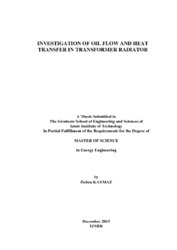Please use this identifier to cite or link to this item:
https://hdl.handle.net/11147/4560Full metadata record
| DC Field | Value | Language |
|---|---|---|
| dc.contributor.advisor | Başaran, Tahsin | - |
| dc.contributor.advisor | Erek, Aytunç | - |
| dc.contributor.author | Kaymaz, Özben | - |
| dc.date.accessioned | 2016-04-27T08:43:23Z | |
| dc.date.available | 2016-04-27T08:43:23Z | |
| dc.date.issued | 2015-12 | - |
| dc.identifier.citation | Kaymaz, Ö. (2015). Investigation of oil flow and heat transfer in transformer radiator. Unpublished master's thesis, İzmir Institute of Technology, İzmir, Turkey | en_US |
| dc.identifier.uri | http://hdl.handle.net/11147/4560 | - |
| dc.description | Thesis (Master)--Izmir Institute of Technology, Energy Engineering, Izmir, 2015 | en_US |
| dc.description | Includes bibliographical references (leaves. 86-87) | en_US |
| dc.description | Text in English; Abstract: Turkish an English | en_US |
| dc.description | xiii, 87 leaves | en_US |
| dc.description.abstract | Transformer losses are produced by the current passing through resistance on the winding conductors. These losses are converted to heat energy as all electrical machines. Transformer life depends on the aging of cellulose-based insulation material in winding. Winding temperature must be kept below a certain temperature limit, because the excess heat in the windings directly accelerates the aging of insulation material. Oil-immersed transformers are cooled by using transformer oil. In this study, flow and heat transfer of transformer radiator filled with mineral oil, silicone oil and ester oil were investigated. Oil in radiator was modelled in 3D, thereby oil flow volume was created, heat transfer calculations were made with using different type transformer oils and investigation of flow behavior is studied. Temperature dependent density, thermal conductivity and viscosity values are obtained from oil suppliers. Transformer oil database was composed by using curve fitting methods in MathCAD Software to use in CFD (Computational Fluid Dynamics) analysis in Fluent software. Finally, the pressure differences were obtained for each oil type. According to the velocity versus pressure difference graph that was obtained from the results of this study, inertial resistance and viscous resistance could be described which are required in future studies to use porous medium approach. Number of elements and computation domain will be decreased by using porous medium approach, then complete transformer model could be analyzed. Additionally, thermal characteristics of transformer oils were obtained and compared in this study. Accordingly, natural ester oil had the best heat transfer and pressure drop. | en_US |
| dc.description.abstract | Transformatör kayıpları sargı iletkeni üzerinden geçen direncin oluşturduğu akımdan kaynaklanır. Tüm elektrik makinelerinde olduğu gibi, oluşan kayıplar ısı enerjisine dönüşür. Transformatör ömrü, sargıda bulunan selüloz bazlı izolasyon malzemesinin yaşlanmasına bağlıdır. Sargı içerisinde oluşan fazla ısı doğrudan doğruya izolasyon malzemesinin yaşlanmasını hızlandırdığı için, sargı sıcaklığı önceden belirlenmiş olan sıcaklık sınırlarında tutulur. Yağlı tip transformatörler, transformatör yağı kullanılarak soğutulmaktadır. Bu çalışmada, mineral yağ, silikon yağ ve ester yağ kullanılan transformatör radyatöründe akış ve ısı transferi incelenmiştir. Radyatör içerisinde bulunan transformatör yağı 3 boyutlu olarak modellenmiş, böylece yağ akış hacmi oluşturulmuş, farklı tipte transformatör yağlarının ısı transferi hesaplamaları yapılmış ve akışın gösterdiği davranış incelenmiştir. Yağ tedarikçilerinden sıcaklığa bağlı olarak değişen yoğunluk, ısı sığası, ısıl iletkenlik ve viskozite değerleri sağlanmıştır. Transformatör yağına ait veriler, ANSYS Fluent simulasyon yazılımında HAD (Hesaplamalı Akışkanlar Dinamiği) analizlerinde kullanılmak üzere, MathCAD yazılımında eğri uydurma yöntemleri ile oluşturulmuştur. Sonuç olarak, rher bir yağ için radyatör boyunca oluşan basınç farkları elde edilmiştir. Bu çalışma neticesinde gelecek çalışmalarda gözenekli ortam yaklaşımının kullanılabilmesi amacı ile hıza bağlı olarak değişen basınç farkları grafiği elde edilmiştir. Böylece gözenekli ortam modellemesinde gerekli olan atalet direnci ve viskoz direnç katsayıları tanımlanabilecektir. Gözenekli ortam yaklaşımı kullanılarak, eleman sayısı ve çözüm süresi düşürülecek, böylece tüm bir transformatör analizi yapılabilecektir. Ayrıca, bu çalışma ile transformatör yağlarının karakteristikleri de elde edilerek, birbirleriyle karşılaştırılmıştır. Buna göre, doğal ester yağ, ısı transferi ve basınç düşümü açısından diğer yağlara göre daha iyi bir performans göstermiştir. | en_US |
| dc.language.iso | en | en_US |
| dc.publisher | Izmir Institute of Technology | en_US |
| dc.rights | info:eu-repo/semantics/openAccess | en_US |
| dc.subject | CFD | en_US |
| dc.subject | Transformer | en_US |
| dc.subject | Transformer oil | en_US |
| dc.subject | Transformer radiator | en_US |
| dc.subject | Fluid dynamics | en_US |
| dc.title | Investigation of Oil Flow and Heat Transfer in Transformer Radiator | en_US |
| dc.title.alternative | Trasformatör Radyatöründe Yağ Akışının ve Isı Transferinin İncelenmesi | en_US |
| dc.type | Master Thesis | en_US |
| dc.institutionauthor | Kaymaz, Özben | - |
| dc.department | Thesis (Master)--İzmir Institute of Technology, Energy Systems Engineering | en_US |
| dc.relation.publicationcategory | Tez | en_US |
| dc.identifier.wosquality | N/A | - |
| dc.identifier.scopusquality | N/A | - |
| item.grantfulltext | open | - |
| item.fulltext | With Fulltext | - |
| item.languageiso639-1 | en | - |
| item.openairetype | Master Thesis | - |
| item.cerifentitytype | Publications | - |
| item.openairecristype | http://purl.org/coar/resource_type/c_18cf | - |
| Appears in Collections: | Master Degree / Yüksek Lisans Tezleri | |
Files in This Item:
| File | Description | Size | Format | |
|---|---|---|---|---|
| T001424.pdf | MasterThesis | 5.25 MB | Adobe PDF |  View/Open |
CORE Recommender
Page view(s)
1,112
checked on Jun 10, 2025
Download(s)
3,668
checked on Jun 10, 2025
Google ScholarTM
Check
Items in GCRIS Repository are protected by copyright, with all rights reserved, unless otherwise indicated.